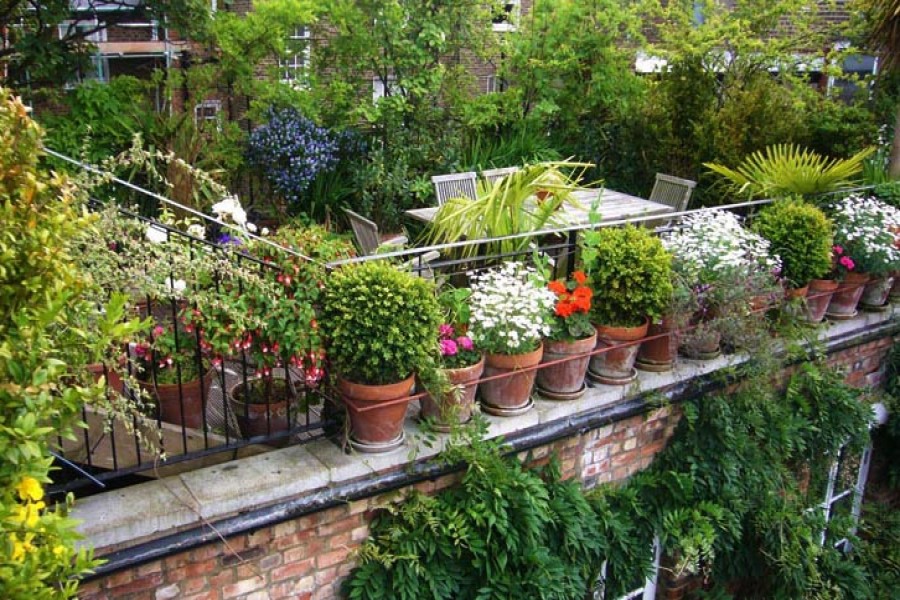The United Nations (UN) agency, Food and Agriculture Organisation (FAO) is usually thought to be associated with country-specific agriculture involving production of cereals and staples. Far from this, its range and scope are extended to even urban gardening including the rooftop category as well. The latest news, not covered by the major newspapers published from the capital city, is that the FAO will finance an urban gardening programme in Dhaka South City Corporation (DSCC) and Dhaka North City Corporation (DNCC) areas, Narayanganj and Gazipur city corporations. Proshika Manobik Unnayan Kendra will be in charge of the technical and logistics support for development of as many as 5,000 urban gardens in these four city corporation areas.
Earlier the FAO provided similar support to rooftop gardening in the capital. This time, the urban gardening or farming programme is expected to be extensive and cover both urban and peri-urban available spaces for growing supplementary foods in order to lessen dependence on vegetables and fruits in particular from the kitchen market.
Many people are likely to dismiss the idea of producing a substantial amount of such foods in a highly crowded city like Dhaka. This is because the concept of gardening to them is not at all clear and, therefore, ludicrous. But urban farming is no figment of imagination, it is real and can adequately synchronise with the prime minister's emphasis on using all available spaces for producing food in order to ensure the country's self-sufficiency in food or food security.
The concept of urban gardening in its broader sense encompasses not just the practice of cultivation of leafy and other vegetables as well as fruits but also animal husbandry, aquaculture, agroforestry, urban beekeeping and horticulture. A few young entrepreneurs by now have successfully developed cattle and dairy farms in the peri-urban areas. Similarly development of urban vegetable farms and orchards is quite possible on fallow lands in such areas. Such farms definitely have an edge over their counterparts in far away districts in processing and distributing foods in and around urban areas.
True, in Dhaka city proper community gardens may sound as an anathema, but in peri-urban areas such as Keraniganj as well as Narayanganj and Gazupur such schemes are more than feasible. The definition of urban farming also includes aquaponics or hydroponics programmes which can conveniently be practised on the backyard or on parts of front lawns of private residences.
Apart from providing with organic indigenous vegetables and fruits such arrangements can help maintain a natural cooling system in the surrounding areas. If the majority of residents go for such gardening or horticulture, the temperature in the locality will remain quite a few degrees lower, enabling them to use their air conditioners sparingly. It does not rule out indoor greenhouses, balconies and patios. So those who are dismissive of the idea may review their conceptual limitations.
So far as livestock is concerned, rearing of chicken, if not managing poultry farms, in urban residences is not uncommon. Aquaculture is almost an unheard of urban practice but the few lakes have long been used for the purpose. This programme can be implemented in the few remaining water bodies in the capital city. But Gazipur is an ideal place for this.
Already the superrich and rich have built sorts of personal resorts for holiday retreat in Gazipur, where the sprawling land property is used for some kind of organic farming. For ordinary citizens, this is unimaginable. It is exactly at this point the initiative taken by the FAO and Proshika can prove most helpful for the poor.
The formal launching of the project titled ' Promoting urban gardening by the urban poor in four cities' at a ceremony held at Khamar Bari, Farmgate on Tuesday last can prove to be a game changer in the availability of supplementary but highly nutritious and safe foods for the common urban residents. Proshika will train 250 trainers from the poor community, who in their turn will train and help 5,000 intended beneficiaries to develop urban gardens. Involved in the entire process will be the councillors and members of local communities.
About the merit of the project there is hardly any doubt but how it will be executed will decide the prospect of such an amazing initiative. Local urban economy varies by margins light years apart with the slums faring worse than villages in poverty, health and hygiene indices. The programme of urban gardening has the potential to improve this condition to a large extent.
Apart from the physical activities such as digging, shovelling and watering which burn calories, there is an emotional aspect associated with gardening. Along with the reduction of carbon footprints, the element of attachment that grows between plants and humans is known as 'horticulture therapy'. The plant-human bond or relationship developed in the process is unique with a calming effect on those involved with this semi-amateurish and spare-time occupation.
Dhaka city cannot expect to have anything similar to the woodlands found in Bangalore but it can surely have its green covers enhanced many times over if the urban gardening is taken to a desirable level and boulevards developed to complement it. The 10 degree Celsius higher temperature in the city compared to the countryside, as a recent study revealed, certainly demands such initiatives if Dhaka has to maintain its liveability.
nilratanhalder2000@yahoo.com


